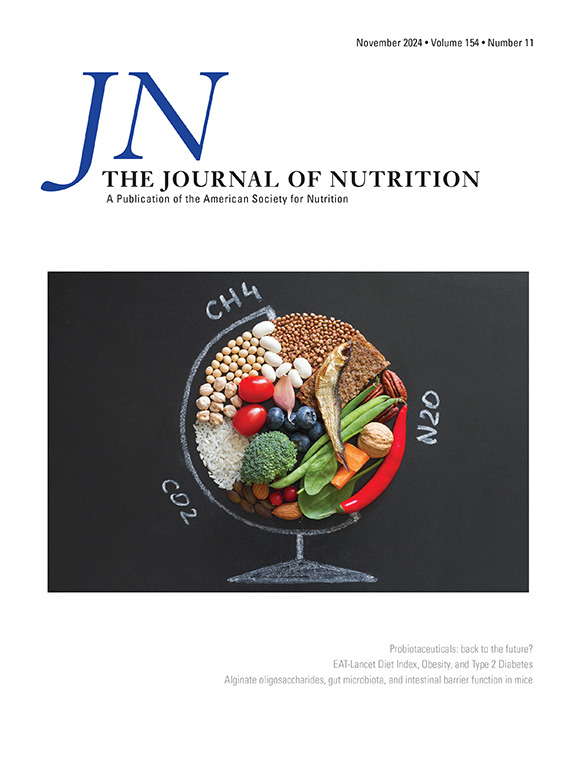产前母亲硒浓度与幼儿神经发育的关系,来自一项母婴队列研究的结果。
IF 3.7
3区 医学
Q2 NUTRITION & DIETETICS
引用次数: 0
摘要
背景:硒(Se)是人体健康和大脑发育所必需的微量营养素。一些研究已经证明了母亲硒浓度与儿童神经发育之间的联系。目的:我们旨在描述尼泊尔怀孕女性的硒状况,并探讨怀孕早期母体硒血浆浓度与尼泊尔儿童早期儿童神经发育之间的关系。方法:队列研究包括来自尼泊尔巴克塔普尔的800对母婴。在妊娠15周内抽取孕妇血样,采用电感耦合等离子体质谱法分析硒浓度。使用Bayley婴幼儿发育量表第3版(Bayley-3)在6、12和24个月时评估儿童神经发育。我们使用线性混合模型来检验母亲血浆硒浓度与贝利-3评分之间的关系,并根据母亲的年龄和社会经济地位进行了调整。结果:产妇血浆硒浓度平均值(标准差)为74.8 μg/L (10.4 μg/L), 290名孕妇(36.3%)硒浓度缺乏(结论:尽管有相当比例的孕妇缺硒,但在我们的尼泊尔健康孕妇队列中,孕妇硒浓度与儿童早期神经发育无关。本文章由计算机程序翻译,如有差异,请以英文原文为准。
The Association Between Prenatal Maternal Selenium Concentration and Neurodevelopment in Early Childhood, Results from a Mother–Child Cohort Study
Background
Selenium (Se) is a micronutrient essential for human health and the developing brain. A few studies have demonstrated associations between maternal Se concentration and child neurodevelopment.
Objectives
We aimed to describe Se status in pregnant Nepalese females and explore the association between maternal Se plasma concentration in early pregnancy and child neurodevelopment measured during early childhood in Nepalese children.
Methods
The cohort study included 800 mother–infant dyads from Bhaktapur, Nepal. Blood samples from pregnant females were drawn within 15 wk of gestation and Se concentration was analyzed by inductively coupled plasma mass spectrometry. Child neurodevelopment was assessed at 6, 12, and 24 mo with the Bayley Scales of Infant and Toddler Development, 3rd edition (Bayley-3). We used linear mixed models to examine the association between maternal plasma Se concentration and Bayley-3 scores, adjusted for maternal age and socioeconomic status.
Results
The mean (standard deviation) maternal plasma Se concentration was 74.8 μg/L (10.4 μg/L), and 290 (36.3%) pregnant females had Se concentration indicating deficiency (<71.1 μg/L). We found no significant association between maternal Se concentration and the Bayley-3 total z-score [Coeff. 0.002 (95% confidence interval: –0.007, 0.011)], and no associations between Se concentration and any of the Bayley-3 composite and subscale scores.
Conclusions
Despite a substantial proportion of pregnant females with Se deficiency, maternal Se concentration was not associated with early childhood neurodevelopment in our study cohort of healthy pregnant Nepalese females.
求助全文
通过发布文献求助,成功后即可免费获取论文全文。
去求助
来源期刊

Journal of Nutrition
医学-营养学
CiteScore
7.60
自引率
4.80%
发文量
260
审稿时长
39 days
期刊介绍:
The Journal of Nutrition (JN/J Nutr) publishes peer-reviewed original research papers covering all aspects of experimental nutrition in humans and other animal species; special articles such as reviews and biographies of prominent nutrition scientists; and issues, opinions, and commentaries on controversial issues in nutrition. Supplements are frequently published to provide extended discussion of topics of special interest.
 求助内容:
求助内容: 应助结果提醒方式:
应助结果提醒方式:


